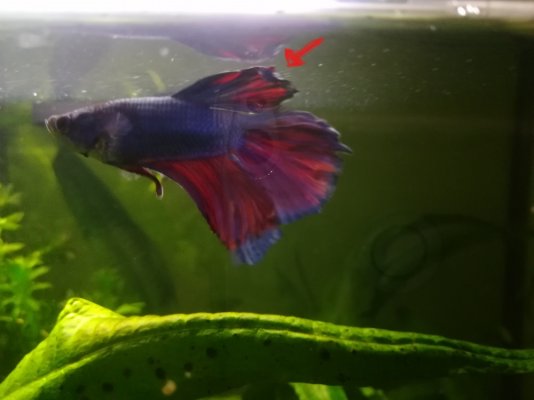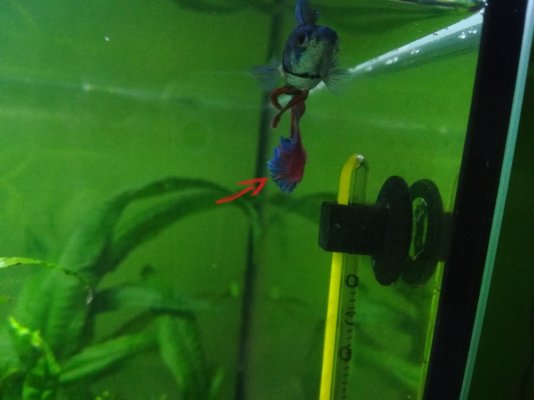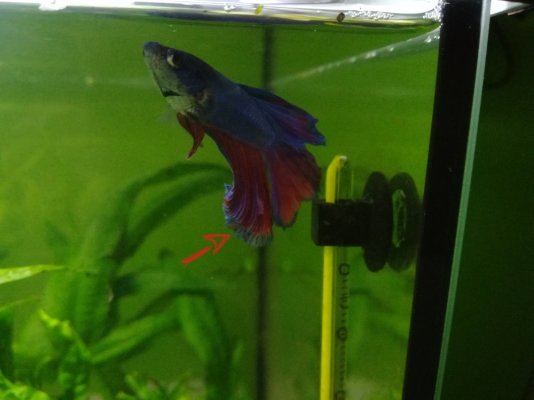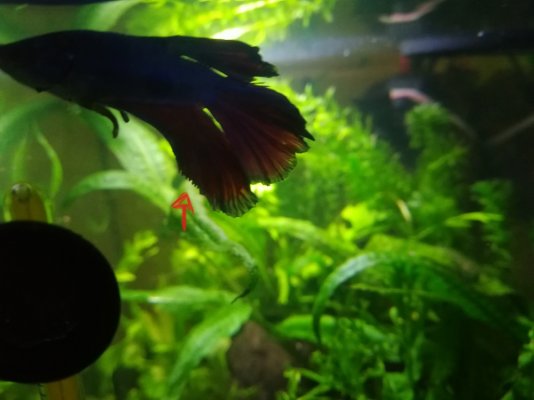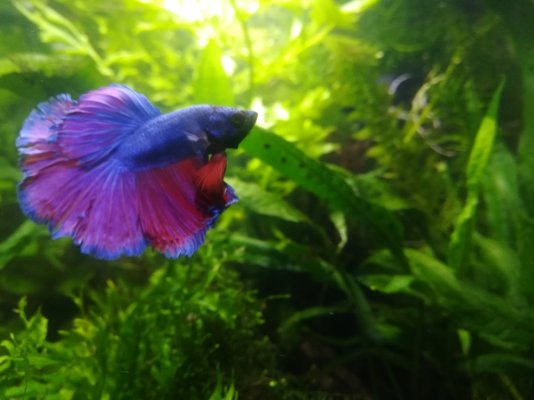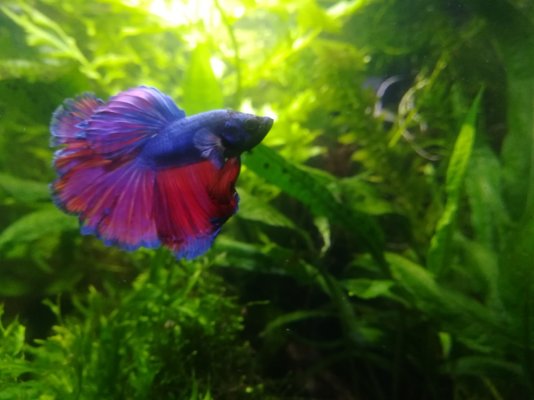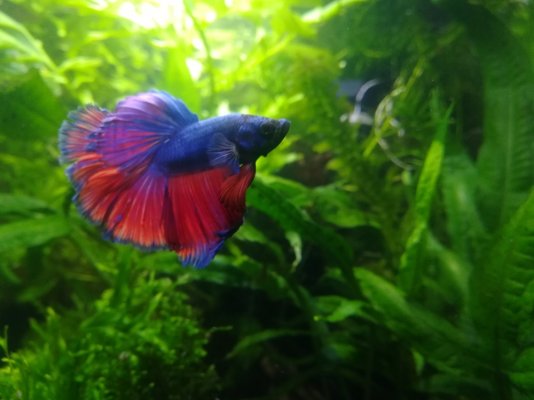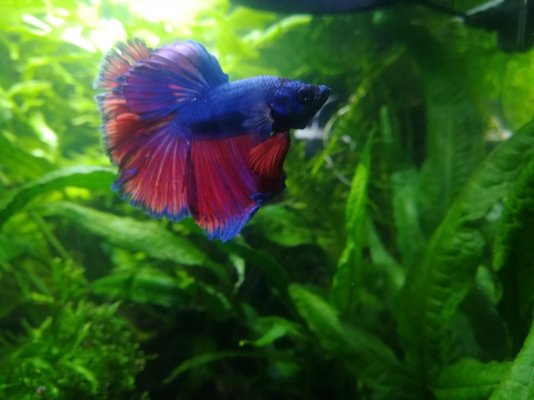Enchantress
Aquarium Advice Activist
- Joined
- Apr 2, 2017
- Messages
- 165
Hi,
Less than a week ago I adopted a male betta (either delta or super delta, it's kind of hard to tell) - he's smaller than the ones I've kept in the past (under 2 inches including the tail), so I'm assuming he's still pretty young. I have no idea what conditions he was kept in by his previous owner, but for some reason over the past few days his fins (especially the ventrals, anal and dorsal fin) have started curling at the ends, and it seems to have gotten worse over the past few days. The rate of progression worries me, because I've only had him for like 5 days. Right now his anal fin is curled completely upwards, and the little bones in it look as though they might pierce the tissue any minute . Some of the rays are also sticking out at weird angles in the fin, almost as if the fin is too delicate to be supported by them. The edges of his fin look crumpled, curled, almost broken, and it's getting worse quicker than I could've expected. I've also noticed 2 small round holes in his tail - not sure if they're mechanical tears or something else.
. Some of the rays are also sticking out at weird angles in the fin, almost as if the fin is too delicate to be supported by them. The edges of his fin look crumpled, curled, almost broken, and it's getting worse quicker than I could've expected. I've also noticed 2 small round holes in his tail - not sure if they're mechanical tears or something else.
Fin rot seems unlikely (I've dealt with it before and this looks different), as he's not showing any other symptoms - no discolouration along the edges, no weird growth on the fins etc. He's active and eating well, his movement doesn't seem hampered by the curling. I noticed him flashing a few times over the past few days, but he seems to have stopped for the time being. Unfortunately I don't have any test kits at hand, so I don't know the water parametres - but he shares the tank with a group of amano shrimp (which are supposedly more sensitive to things like ammonia and nitrates than fish), and the fish that used to live in this tank before him didn't have this issue. It's the first time I'm encountering something like this, and I've had this tank for almost 3 years. Just in case I ordered a few Catappa leaves to soften the water a bit, as I've heard curling may occur due to hard water, which - judging by the lime deposits under the cover - I might have (again, not sure). I'm worried that if this progresses any further he'll end up with seriously damaged fins or broken rays, not really sure what to expect at this point.
The tank is about 10-11gal (45l), temperature is 77 degrees, I do weekly water changes of about 22%. The tank is heavily planted and of course filtered. Apart from the shrimp he's the only fish in there.
Any ideas as to what more I can do, or what could be causing this would be greatly appreciated
I'm attaching some pictures of him - excuse the quality, my phone can't do any better and he's a pretty active little fish
Less than a week ago I adopted a male betta (either delta or super delta, it's kind of hard to tell) - he's smaller than the ones I've kept in the past (under 2 inches including the tail), so I'm assuming he's still pretty young. I have no idea what conditions he was kept in by his previous owner, but for some reason over the past few days his fins (especially the ventrals, anal and dorsal fin) have started curling at the ends, and it seems to have gotten worse over the past few days. The rate of progression worries me, because I've only had him for like 5 days. Right now his anal fin is curled completely upwards, and the little bones in it look as though they might pierce the tissue any minute
Fin rot seems unlikely (I've dealt with it before and this looks different), as he's not showing any other symptoms - no discolouration along the edges, no weird growth on the fins etc. He's active and eating well, his movement doesn't seem hampered by the curling. I noticed him flashing a few times over the past few days, but he seems to have stopped for the time being. Unfortunately I don't have any test kits at hand, so I don't know the water parametres - but he shares the tank with a group of amano shrimp (which are supposedly more sensitive to things like ammonia and nitrates than fish), and the fish that used to live in this tank before him didn't have this issue. It's the first time I'm encountering something like this, and I've had this tank for almost 3 years. Just in case I ordered a few Catappa leaves to soften the water a bit, as I've heard curling may occur due to hard water, which - judging by the lime deposits under the cover - I might have (again, not sure). I'm worried that if this progresses any further he'll end up with seriously damaged fins or broken rays, not really sure what to expect at this point.
The tank is about 10-11gal (45l), temperature is 77 degrees, I do weekly water changes of about 22%. The tank is heavily planted and of course filtered. Apart from the shrimp he's the only fish in there.
Any ideas as to what more I can do, or what could be causing this would be greatly appreciated
I'm attaching some pictures of him - excuse the quality, my phone can't do any better and he's a pretty active little fish

